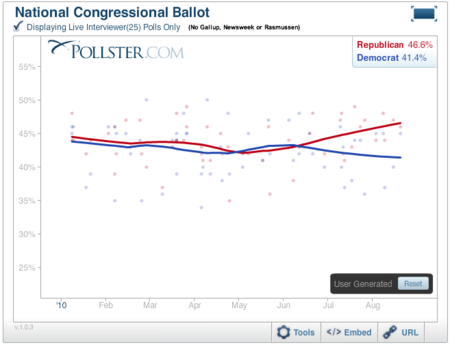Two national polls released today and over the weekend report very different results leading to very different conclusions:
On Friday, under the headline "Democrats May Not Be Headed for Midterm Bloodbath," Newsweek reported results from a new national poll of registered voters showing Americans evenly split (45% to 45%) on the question of whether they would vote for the Democratic or Republican candidate for Congress in their district.
This afternoon, Gallup released another national survey of registered voters, also conducted last week, showing Republicans with an "unprecedented 10-point lead" (51% to 41%), the largest Republican advantage Gallup has measured in its nearly sixty years of tracking the so-called "generic ballot."
So what's going on?
Much of the gaping difference between the two polls is probably explained by the usual random variation that affects all polls. Use your mouse to poke around our interactive chart (posted below), and you will soon discover that the latest Gallup survey result is more favorable for the Republicans than most, the Newsweek poll is similarly more favorable for the Democrats and that both fall within the typical range of variation, amounting to +/- three or four points from the trend line. Our overall trend estimate based on all of the available polls gives Republicans a 5.2 percentage point advantage (46.8% to 41.6%)
We could obsess further over the consistent differences ("house effects") among pollsters, but what is far more important, is that the averages show a GOP lead that has been trending in the Republican direction all summer. That trend is consistent with the historical pattern identified here on Friday by political scientists Joe Bafumi, Bob Erikson and Chris Wlezien, the "electorate's tendency in past midterm cycles to gravitate further toward the "out" party over the election year."
Moreover, you see the same trend even if we drop all Newsweek and Gallup polls, plus all of the Internet-based surveys and automated surveys (including Rasmussen), and focus only on the remaining live-interviewer telephone surveys, as in the chart below. The margin for the Republicans is virtually identical (46.6% to 41.4%).
So while the "unprecedented 10-point lead" reported by Gallup probably exaggerates the Republican lead, any result showing a net Republican advantage on the so-called generic ballot is bad news for Democrats. Bafumi and his colleagues estimated their 50-seat gain for the Republicans assuming a two-point advantage for Republicans on the generic ballot, which they project will widen to a six-point lead by November. If the Republican lead on the generic ballot is already that wide (or close), their projection for the Democrats would worsen.

